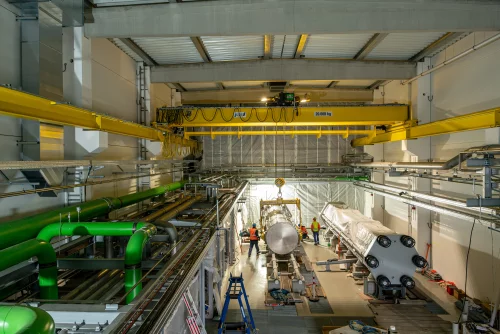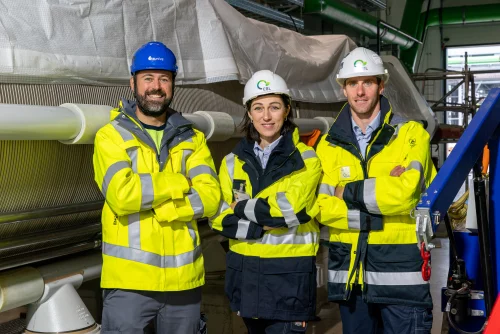Energiepark Bad Lauchstädt on the final stretch: Electrolyzer for producing green hydrogen takes shape
First electrolysis stacks for industrial-scale production of climate-neutral hydrogen arrived
With the first stacks, the installation of the electrolyzer, which is being built by Uniper and VNG Handel & Vertrieb GmbH (VNG H&V), is beginning at the Energiepark Bad Lauchstädt. It is the heart of hydrogen production and the final piece of the puzzle that paves the way for green H₂ production in Bad Lauchstädt. Here, wind power and water are used to produce climate-neutral hydrogen – an energy carrier that can be stored and used flexibly. It is precisely this sector coupling that is the key to the energy transition.
Once the installation is complete, commissioning will begin. “This is an emotional moment for the project team, showing how far we have come. After commissioning, green hydrogen will be produced here on an industrial scale for the first time. Up to 4,000 tons per year,” explains Cornelia Müller-Pagel, spokesperson for the Energiepark Bad Lauchstädt Energiepark consortium. “This enables us to make an important contribution to supplying the Central German chemical triangle. Above all, however, the Energiepark demonstrates that hydrogen projects in Germany are not only technically feasible, but also economically viable – and thus can become a cornerstone of the energy transition.”
From electrolysis stack to large-scale modular plant
The pressure alkali electrolyzer at the Energiepark Bad Lauchstädt, developed and manufactured by Dresden-based specialist Sunfire, consists of three modules, each with a capacity of 10 megawatts. Each module is made up of two stacks, with each stack consisting of four blocks. The 12-ton electrolyzer blocks are delivered in 24 individual shipments, which are then delivered on site by flatbed trucks. “The stacks are the heart of the electrolyzer. Their delivery marks the transition from the construction to the implementation phase and is the result of months of hard work by the entire team,” says Xenia Papst, Senior Commercial Manager Hydrogen Germany at Uniper. "The stacks convert the renewable electricity from the wind turbines of the Energiepark into hydrogen – efficiently, modularly, and scalably. With each additional stack, the plant's output grows until we finally reach 30 MW and can connect the central component to the supply."
Aron Guttowski, Senior Manager Project Management Electrolysis at Sunfire, adds: "A real-world laboratory like this one demonstrates how valuable it is to work with strong partners. Together, we pool our many years of experience and expertise in the field of hydrogen, learn from each other, and strengthen each other. At the same time, it becomes clear that hydrogen technologies, such as those used in Bad Lauchstädt, are already working today and are ready for practical use in industry."
Signal effect for energy transition and industry
The hydrogen produced is transported to the TotalEnergies refinery 25 kilometers away via a former natural gas pipeline belonging to ONTRAS Gastransport GmbH – a concrete example of how fossil fuels and infrastructure can be repurposed for climate-neutral alternatives. The Energiepark Bad Lauchstädt is one of the largest pilot projects of its kind in Europe and demonstrates how renewable energies, modern electrolysis technology, and transport solutions can be combined into an integrated system that paves the way for a climate-neutral economy. “With the start of electrolysis, we are not only securing the next technological leap, but also the long-term economic viability of the energy park,” emphasizes Sebastian Pflüger, Senior Project Manager Hydrogen at VNG H&V. “Green hydrogen is not only produced here, but also used directly on site – this creates value chains that are attracting international attention.” For the first time, the entire green hydrogen process chain is being tested on an industrial scale in the real-world laboratory in Bad Lauchstädt – from production using renewable electricity to use in the regional chemical industry. The project is thus not only contributing to decarbonization but also strengthening the innovative power and competitiveness of Central Germany as an industrial location. But the Energiepark Bad Lauchstädt is also sending a strong signal beyond the region's borders: it shows how ambitious climate targets can be advanced through concrete industrial implementation.
© Photo credit: Tom Schulze



